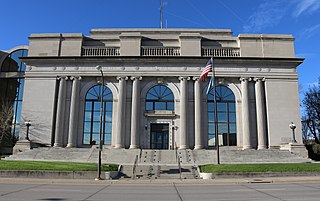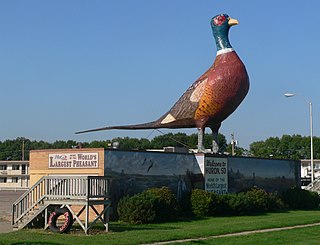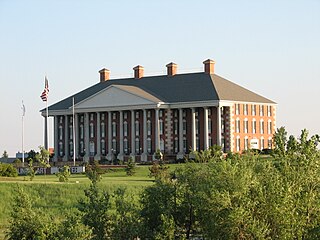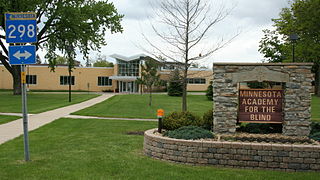
Pierre is the capital city of South Dakota and the seat of Hughes County. The population was 14,091 at the 2020 census, making it the second-least populous state capital in the United States, following Montpelier, Vermont. It is the ninth-most populous city in South Dakota. Founded in 1880, it was selected as the state capital when the territory was admitted as a state. Pierre is the principal city of the Pierre Micropolitan Statistical Area, which includes all of Hughes and Stanley counties.

Stanley County is a county in the U.S. state of South Dakota. As of the 2020 census, the population was 2,980. Its county seat is Fort Pierre. The county was created in 1873, and was organized in 1890. It is named for David S. Stanley, a commander at Fort Sully from 1866 to 1874, which was located nearby.

Pennington County is a county in the U.S. state of South Dakota. As of the 2020 census, the population was 109,222, making it the second-most populous county in South Dakota. Its county seat is Rapid City. The county was created in 1875, and was organized in 1877. It is named for John L. Pennington, fifth Governor of Dakota Territory, who held office in 1875 when the county was formed.

Huron is a city in Beadle County, South Dakota, United States. It is the county seat of Beadle County. The Huron Daily Plainsman, also referred to as the Plainsman, is the newspaper. The first settlement at Huron was made in 1880. The city was named after the Huron Indians. It is currently the eighth largest city in South Dakota, but it once was the fourth. In recent years, Huron's population has once again started to grow after nearly 20 years of stagnation. A welcoming immigration policy coupled with an economic revival in the area has sparked development. A Walmart Supercenter opened in the mid 2000s. Since Walmart's opening more commercial and residential development has occurred with the completion of a new Runnings store, and many new apartments, twin homes and houses.

Brookings is a city in Brookings County, South Dakota, United States. Brookings is South Dakota's fourth largest city, with a population of 23,377 at the 2020 census. It is the county seat of Brookings County, and home to South Dakota State University, the state's largest institution of higher education. Also in Brookings are the South Dakota Art Museum, the Children's Museum of South Dakota, the annual Brookings Summer Arts Festival, and the headquarters of several manufacturing companies and agricultural operations.

Vermillion is a city in and the county seat of Clay County. It is in the southeastern corner of South Dakota, United States, and is the state's 12th-largest city. According to the 2020 Census, the population was 11,695. The city lies atop a bluff near the Missouri River.

Watertown is a city in and the county seat of Codington County, South Dakota, United States. Watertown is home to the Redlin Art Center which houses many of the original art works produced by Terry Redlin, one of America's most popular wildlife artists. Watertown is located between Pelican Lake and Lake Kampeska, from which Redlin derived inspiration for his artwork.

Howard is a city in Miner County, South Dakota, United States. The population was 848 at the 2020 census. It is the county seat and most populous city in Miner County.

Fort Pierre is a city in Stanley County, South Dakota, United States. It is part of the Pierre, South Dakota micropolitan area and the county seat of Stanley County. The population was 2,115 at the 2020 census.

The University of South Dakota (USD) is a public research university in Vermillion, South Dakota. Established by the Dakota Territory legislature in 1862, 27 years before the establishment of the state of South Dakota, USD is the flagship university for the state of South Dakota and the state's oldest public university. It occupies a 274 acres (1.11 km2) campus located in southeastern South Dakota, approximately 63 miles (101 km) southwest of Sioux Falls, 39 miles (63 km) northwest of Sioux City, Iowa, and north of the Missouri River.
The State Library of Oregon in Salem, is the library for the U.S. state of Oregon. The mission of the State Library of Oregon is to provide leadership and resources to continue growing vibrant library services for Oregonians with print disabilities, the Legislature and state government, and all Oregonians through local libraries.

Minnesota State Academy for the Blind (MSAB) is a public school in Faribault, Minnesota, United States. Its mission is the education and life education of blind, visually impaired, and deaf-blind learners from birth to age 21. The school has a residential program and provides 24-hour programming including Braille, independent travel, assistive technologies, and individualized educational services. Students often have multiple disabilities and come from all regions of the state.

Kristi Lynn Noem is an American politician serving since 2019 as the 33rd governor of South Dakota. A member of the Republican Party, she was the U.S. representative for South Dakota's at-large congressional district from 2011 to 2019 and a member of the South Dakota House of Representatives for the 6th district from 2007 to 2011. Noem was elected governor in 2018 and is South Dakota's first female governor. She was elected as an ally of Donald Trump.

The South Dakota State Penitentiary is a state prison located in South Dakota's largest city, Sioux Falls. The building's industry shop makes several things for the state, including woodwork and license plates. The State Penitentiary also houses South Dakota's death row for men and the state's execution chamber.
The South Dakota State Historical Society is South Dakota's official state historical society and is located in Pierre, South Dakota at 900 Governors Drive. It is a part of the South Dakota Department of Education.
The South Dakota Cultural Heritage Center in Pierre, South Dakota, is the headquarters of the South Dakota State Historical Society. Opened in 1989, the center houses the State Historical Society’s administrative, historic preservation, and research and publishing offices. The Center is also the home of the State Archives and Museum which manages the South Dakota Digital Archives. Through these five programs, the South Dakota State Historical Society preserves and interprets the history and culture of South Dakota and its people.
The Rapid City, Black Hills and Western Railroad, also known simply as the Black Hills and Western Railroad and commonly referred to as the Rapid Canyon Line or the Crouch Line, is a defunct standard gauge freight railroad line that operated in the Black Hills in the U.S. state of South Dakota. The railroad became known throughout the area for its crookedness and later became a tourist attraction. It ran from Rapid City to Mystic for a distance of 36.043 miles. The railroad ceased operations in 1947.

The South Dakota Library Association (SDLA) is a professional organization for South Dakota's librarians and library workers to "promote libraries within the state and provide library service for the populace."

The Illinois State Library is the official State Library of Illinois located in Springfield, Illinois. The library has a collection of 5 million items and serves as regional federal documents depository for the state. The library oversees the Talking Book and Braille Service which offers audio and braille library service to Illinois residents with print disabilities or other disabilities. The library maintains the Illinois Center for the Book, the Illinois Digital Archives and the Illinois Veterans History Project.

The Lake Andes Carnegie Library, in Lake Andes, South Dakota in Charles Mix County, South Dakota, is a Carnegie library which was built in 1911. It was listed on the National Register of Historic Places in 2000.
















